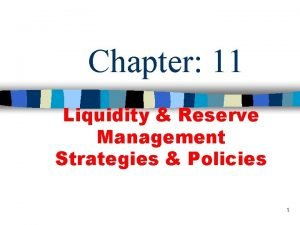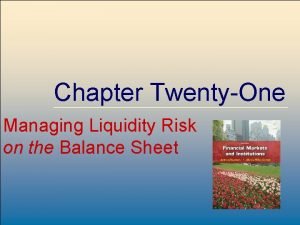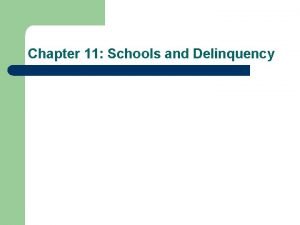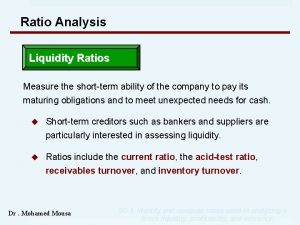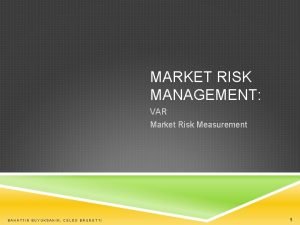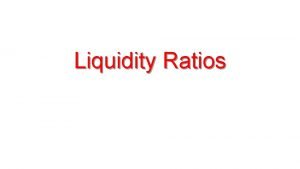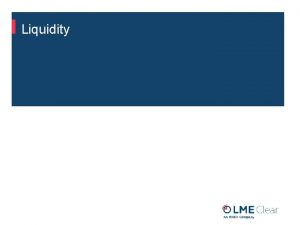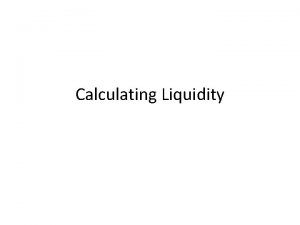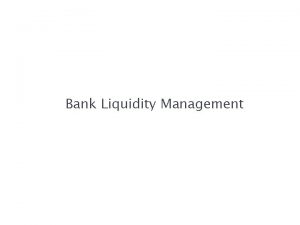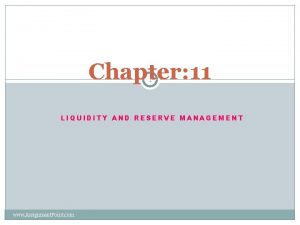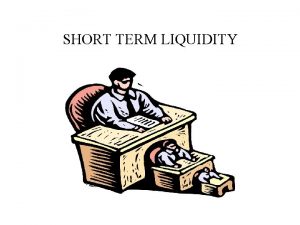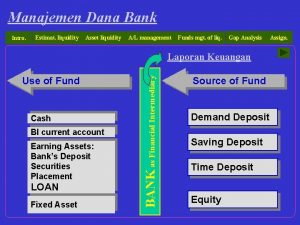Chapter 11 Liquidity Reserve Management Strategies Policies 1


















- Slides: 18

Chapter: 11 Liquidity & Reserve Management Strategies & Policies 1

Supplies of Liquidity Flowing into Banks. n n n Incoming deposits. Revenues from the sale of nondeposit services. Customer loan repayments. Sales of bank assets. Borrowings from the money market. 2

Demands on the Bank for Liquidity n n n Deposits withdrawals. Volume of acceptable loan requests. Repayment of bank borrowings. Other operating expenses. Dividend payments to bank stockholders. 3

Net Liquidity Position (Lt) n The difference between the total supply of liquidity flowing into a bank & the demands made upon the bank for liquidity. The most pressing demands for spendable funds come from two sources: 1. Customers withdrawing money from their deposit. 2. Credit requests from customers. 4

Implications of Liquidity Management Rarely are the demands for bank liquidity equal to the supply of liquidity at any particular point of time. ü There is a trade-off between bank liquidity & profitability. High degree of liquidity will reduce the bank’s expected profitability. ü 5

Why banks face significant liquidity problem? Imbalance between the maturity dates on their assets & the maturity dates attached with their liabilities, i. e, high proportion of demand deposit & high proportion of long-term lending. n Sensitivity to changes of interest rates. If other banks offer high interest rate, some customer will withdraw their funds for better returns elsewhere. n Bank’s attitude towards lending & providing services to the depositors. n 6

Strategies for Liquidity Managers 1. 2. 3. Providing liquidity from assets (Asset Liquidity Management). Relying on borrowed liquidity to meet cash demands (Liability Management). Balanced Liquidity Management (Asset & Liability). 7

1) Asset Liquidity Management Strategies n Reliance on liquid assets that can be readily sold for cash to meet a bank’s liquidity needs. A liquid asset must have three characteristics: – Ready Market. – Stable Price. – Reversible. n This strategy is used mainly by small banks that find it a less risky approach than relying on borrowings. 8

Implications of Asset Liquidity Management Strategies Ø Ø Ø Selling assets means the bank loses the future earnings possibility. Selling assets involve transaction cost paid to the security brokers. Asset in question may need to be sold in a market experiencing declining prices. (capital loss possibility) Selling assets tends to weaken the appearance of the bank’s balance sheet. Liquid assets generally holds lowest rate of return, i. e, by investing in liquid assets, banks are ignoring the possibility of higher return on other financial assets. 9

2)Borrowed Liquidity Management Strategies n Reliance upon borrowed funds to meet a bank’s liquidity needs. The sources of borrowed funds: ü Federal funds borrowing. ü Repos. ü Issuing large negotiable CDs to major corporation, government & wealth individuals. ü Issuing Eurocurrency deposits. ü Borrowing reserves from the discount of the central bank. q This is the most risky approach to solving liquidity problems because of the volatility of money market interest rates & the rapidity with which the availability of credit can change. 10

3) Balanced Liquidity Management Strategies n The combined use of liquid asset holdings & borrowed liquidity to meet a bank’s liquidity needs. 11

Estimating A Bank’s Liquidity Needs n Three approaches in measuring estimating a bank’s liquidity needs: or 1. The sources & uses of fund approach. 2. The structure of funds approach. 3. Liquidity indicator approach. 12

1) The Sources & Uses of fund approach. n A method for estimating a bank’s liquidity requirements by focusing primarily on expected changes in deposits & loans. The approach begins with two simple facts: v Bank liquidity rises as deposits increase & loans decrease. v Bank liquidity declines when deposits decrease & loans increase. § Estimated liquidity deficit (-) or surplus (+) for the coming period = estimated changes in total deposits (D) – estimated change in total loans (L) 13

2) The Structure of Funds Approach n A method for estimating a bank’s liquidity needs by dividing its borrowed funds into categories based upon their probability of withdrawal. The categories are: 1. 2. 3. “Hot Money Liabilities”: Deposits & Non Deposit Borrowed funds that are very interest sensitive & will be withdrawn during the current period. Vulnerable Funds: Customer deposits of which a substantial portion (25%-30%) will probably be removed during the current period. Stable Funds: Most unlikely to be removed during the current period. 14

The Structure of Funds Approach…contd. n Total Liquidity Requirement for a Bank = 0. 95 X (Hot money funds – legal reserves held) + 0. 30 X (Vulnerable deposits – legal reserves held) + 0. 15 X (Stable deposits – legal reserves held) + 1. 00 X (Potential loans outstanding – Actual Loans outstanding) 15

3) Liquidity Indicator Approach 1. 2. 3. 4. 5. 6. Cash position indicator = cash & deposits due from depository institutions / total assets. Liquid securities indicator = government securities / total assets. Net federal funds position = federal funds sold – federal funds purchased/ total asset Capacity ratio = net loans & leases / total assets. Pledged securities ratio = pledged securities / total securities holdings. Hot money ratio = money market assets / money market liabilities. 16

Liquidity Indicator Approach…contd. 7. 8. 9. 10. n Deposit brokerage index = brokered deposits / total deposits. Core deposit ratio = core deposits / total assets. Deposit composition ratio = demand deposits / time deposits. Loan Commitment Ratio= Unused loan Commitments/ Total Assets These indicators are highly sensitive to the season of the year & the stage of the business cycle. Liquidity indicator often decline at boom period due to high loan demand & vice versa. 17

Legal Reserves & Money Position Management n Legal reserves are the assets that a central bank requires depository institutions to hold as a reserve behind their deposits or other liabilities. n Total required legal reserves = {reserve requirements on transaction deposits X daily average amount of net transaction deposits over a designated period} + {reserve requirements on nontransaction reservable liabilities X daily average amount of nontransaction reservable liabilities } 18
 Liquidity and reserve management
Liquidity and reserve management Contingency reserve vs management reserve
Contingency reserve vs management reserve Liquidity management strategies
Liquidity management strategies Source of capital reserve
Source of capital reserve Difference between capital reserve and reserve capital
Difference between capital reserve and reserve capital Stored liquidity management
Stored liquidity management Balanced liquidity management strategy
Balanced liquidity management strategy Xborder funding mc
Xborder funding mc Nps management policies
Nps management policies Human resource policy
Human resource policy Ebay business policy
Ebay business policy Chapter 11 school policies and their functions
Chapter 11 school policies and their functions Chapter 6 supply demand and government policies
Chapter 6 supply demand and government policies Liquidity premium theory
Liquidity premium theory Liquidity ratio
Liquidity ratio Money supply and credit creation
Money supply and credit creation Varmarket
Varmarket Simon slide control
Simon slide control Liqudity ratio
Liqudity ratio


